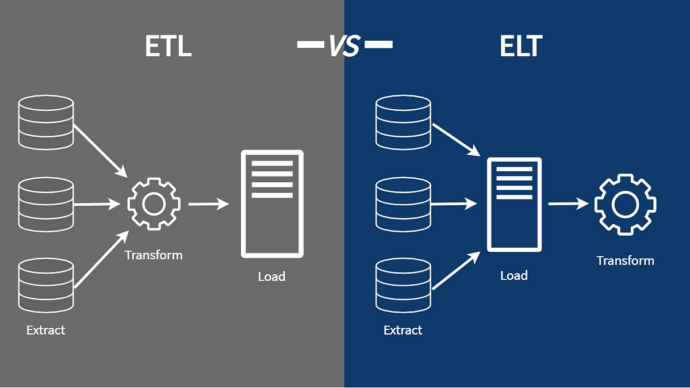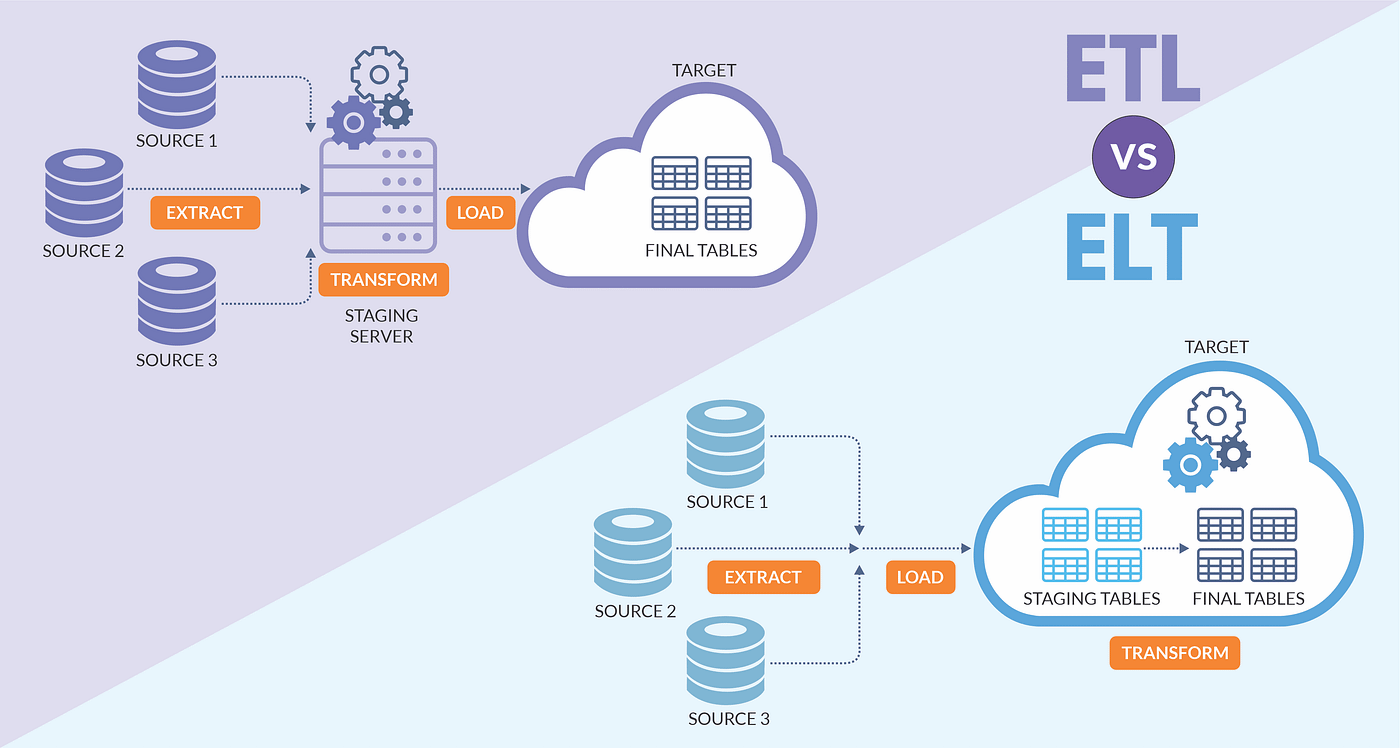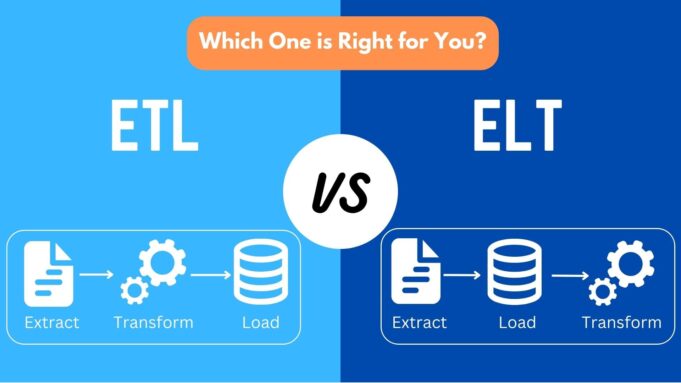ETL processes typically involve heavy data transformation and manipulation before loading data into the target system. ETL tools often include robust functionalities for data quality checks, enrichment, and compliance with business rules, making them suitable for enterprises requiring meticulous data preparation.
In the realm of data integration, organizations often face the dilemma of choosing between two common approaches ─ Extract, Transform, Load (ETL) and Extract, Load, Transform (ELT).
Both methodologies offer unique advantages and considerations, making it essential for businesses to evaluate their specific needs and requirements before making a decision.
Additionally, the selection process may involve assessing various ETL pipeline tools available in the market to determine their compatibility with organizational goals and infrastructure.
In this article, we’ll explore the differences between ETL and ELT, the factors to consider when choosing between them, and best practices for selecting the approach that best suits your business needs.
Understanding ETL and ELT

ETL (Extract, Transform, Load)
In the ETL approach, data is extracted from source systems, transformed according to predefined business rules and transformations, and then loaded into a target data warehouse or database. ETL processes typically involve heavy data transformation and manipulation before loading data into the target system.
ELT (Extract, Load, Transform)
In contrast, the ELT approach involves extracting data from source systems and loading it directly into a target data store, such as a data lake or data warehouse, without significant transformation. Transformation and data processing occur within the target system, often using distributed processing frameworks or SQL-based transformations.
Factors to Consider
When choosing between ETL and ELT, organizations should consider the following factors:
- Data volume and complexity ─ ETL is well-suited for scenarios where data volumes are moderate, and complex transformations are required before loading data into the target system. ELT, on the other hand, is ideal for handling large volumes of raw data without significant transformation upfront.
- Performance and scalability ─ ELT offers superior performance and scalability compared to ETL, particularly when dealing with large datasets. By leveraging distributed processing frameworks and parallel processing capabilities, ELT can process data faster and scale horizontally to accommodate growing data volumes.
- Data quality and governance ─ ETL provides greater control over data quality and governance by enabling organizations to enforce data cleansing, validation, and enrichment rules before loading data into the target system. ELT, however, may require additional governance measures within the target system to ensure data quality and integrity.
Best Practices for Choosing Between ETL and ELT

Evaluate Business Requirements
Start by evaluating your business requirements, including data volumes, complexity, performance expectations, and governance needs. Consider factors such as data sources, data types, latency requirements, and compliance regulations. Understanding these requirements will help you determine whether ETL or ELT is better suited to meet your specific business objectives.
Assess Technical Capabilities
Assess your organization’s technical capabilities, including expertise in data integration tools, data processing frameworks, and infrastructure requirements. Determine whether your team has the skills and resources to implement and manage ETL or ELT workflows effectively. The choice between ETL and ELT may depend on the existing skill set of your data team and the available technological infrastructure.
Prototype and Test
Conduct prototype and proof-of-concept tests to evaluate the feasibility and performance of both ETL and ELT approaches in your specific environment. Assess factors such as data processing times, scalability, data quality, and governance to make an informed decision. Prototyping allows you to identify potential challenges and fine-tune your approach before full-scale implementation.
Consider Hybrid Approaches
In some cases, a hybrid approach that combines elements of both ETL and ELT may be the most suitable option. For example, you may use ETL for initial data ingestion and transformation and then leverage ELT for incremental updates and processing.
This hybrid strategy allows organizations to balance the strengths of both methodologies, ensuring comprehensive data preparation and efficient processing.
Integration and Infrastructure Considerations

Choosing between ETL and ELT involves more than just evaluating the data transformation methodologies; it also requires a thorough understanding of your organization’s existing infrastructure and integration capabilities.
ETL processes typically require dedicated ETL tools and platforms that provide the necessary functionality for data extraction, transformation, and loading. These tools often integrate seamlessly with on-premise databases and traditional data warehouses, making them a preferred choice for organizations with established, structured data environments.
On the other hand, ELT processes take advantage of modern cloud-based data storage and processing platforms. With the advent of powerful cloud services such as Amazon Redshift, Google BigQuery, and Microsoft Azure Synapse Analytics, ELT can leverage the scalable computing power of these platforms to handle vast amounts of data.
This shift towards cloud-native architectures means that organizations with a strong cloud presence might find ELT more aligned with their infrastructure strategy. Additionally, these cloud platforms offer advanced features like automated scaling, robust security measures, and integrated data analytics tools, further enhancing the capabilities of ELT.
Cost Implications

Cost is another critical factor to consider when deciding between ETL and ELT. ETL processes, with their reliance on specialized tools and on-premise hardware, can involve significant upfront investments in software licenses, hardware, and ongoing maintenance.
These costs can be justified for organizations with stringent data quality requirements and the need for comprehensive data transformation before loading.
Conversely, ELT can offer cost efficiencies, particularly in cloud environments where the pay-as-you-go pricing model allows organizations to scale their data processing capabilities without substantial initial investments.
By utilizing the processing power of cloud data warehouses, ELT reduces the need for separate ETL tools and hardware, leading to potential cost savings. However, it’s important to consider the operational costs associated with cloud services, including data storage, compute time, and data egress charges, to ensure a comprehensive cost-benefit analysis.
Conclusion
Choosing between ETL and ELT is a critical decision that depends on various factors, including data volume, complexity, performance, scalability, and governance requirements.
By understanding the differences between ETL and ELT, evaluating business and technical considerations, and following best practices for decision-making, organizations can select the approach that best aligns with their business needs and objectives.
Whether it’s ETL, ELT, or a hybrid approach, the key is to ensure that data integration processes are efficient, scalable, and capable of delivering timely insights to support informed decision-making and drive business success.















